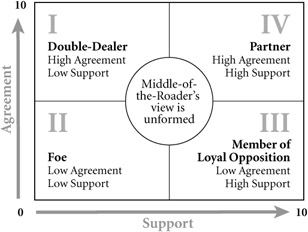Assessing Where Others Stand
What made Susan Fullman successful in her role at United Airlines was her ability to develop framing strategies for dealing with her colleagues. In other words, she was able to home in on a particular situation, assess each player in terms of the degree of agreement and support for the issue on the table, and then develop a strategy for winning them over.
Figure 5-1 provides a key to developing framing strategies. It depicts people in terms of two variables : the degree to which they agree with you and the amount of support they are willing to give you. Agreement is represented by the vertical axis, with 0 indicating total lack of agreement and 10 complete agreement. Support, on the horizontal axis, ranges from 0 (no support whatsoever) to 10 (total, unreserved support).

Figure 5-1: Matrix for Framing Strategies.
Do not attempt to bring a colleague around to your point of view unless you have a clear answer to the following two questions:
-
To what extent does the individual agree with your mission? In other words, does the person share the same fundamental goals as you, and is he or she working toward the same end?
-
To what extent can you count on this person as a supporter?
Once you have the answers to these questions, you can begin to outline a strategy for dealing with the individual in question. The matrix for framing strategies presents the range of available options, considering the two crucial dimensions of agreement and support.
The Double-Dealers described in Quadrant I agree with you at the business-concept level but have, for some reason, decided to withhold their support. Do not waste time presenting a business case to these people: You are preaching to the converted. The key challenge here is to win their support. Suggestion: Focus on listening to their concerns, encouraging them to speak candidly, and working to build trust between you.
The foes in Quadrant II are the immovable forces in the work environment. They neither agree with your goals nor are they among your supporters. Influencing foes can be a Herculean task. Expect foes to be locked into going-in stories that prevent them from engaging authentically. Until you understand what beliefs are keeping them from taking an objective view, you will be unable to exercise any influence over them. Suggestion: Encourage candor, story sharing, and the forging of new agreements for moving ahead.
The Members of the Loyal Opposition in Quadrant III support you while disagreeing with your point of view. They trust you but are at odds with your approach to an issue. With this group , your strategy must be the polar opposite of that used with the Double-Dealers. Suggestion: Present a strong business case, as objectively as possible, to turn your colleagues around.
The remaining two groups ”the Partners in Quadrant IV and the Middle-of-the-Roaders in the center ”present opportunities. The former group supports you and agrees with you. Having them in your corner is an excellent way to demonstrate to others the value of your ideas. Partners can have a positive influence on other groups, especially the Middle-of-the-Roaders. These individuals, who have yet to form an opinion, can be transformed into strong supporters if you can identify their concerns and develop a plan to address them. Suggestions: Enlist the aid of Partners. Engage in candid dialogue with the Middle-of-the-Roaders, and you will likely transform them into partners.
EAN: 2147483647
Pages: 99